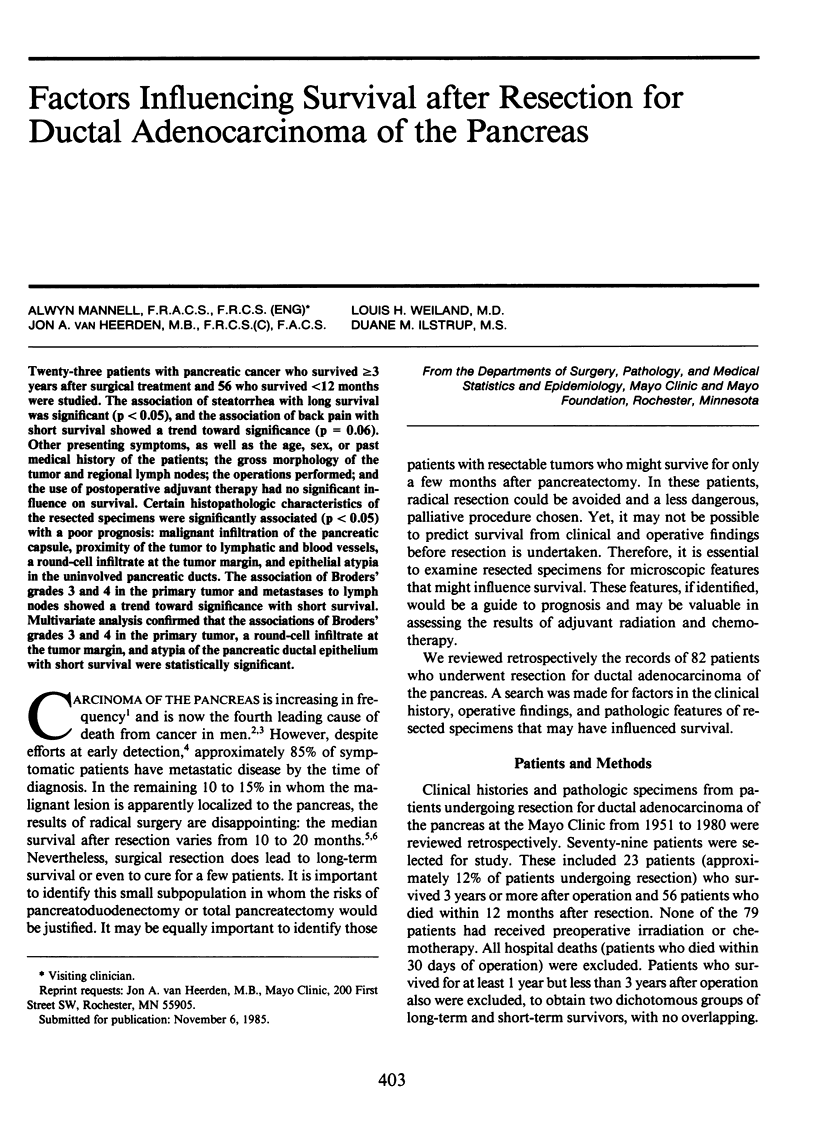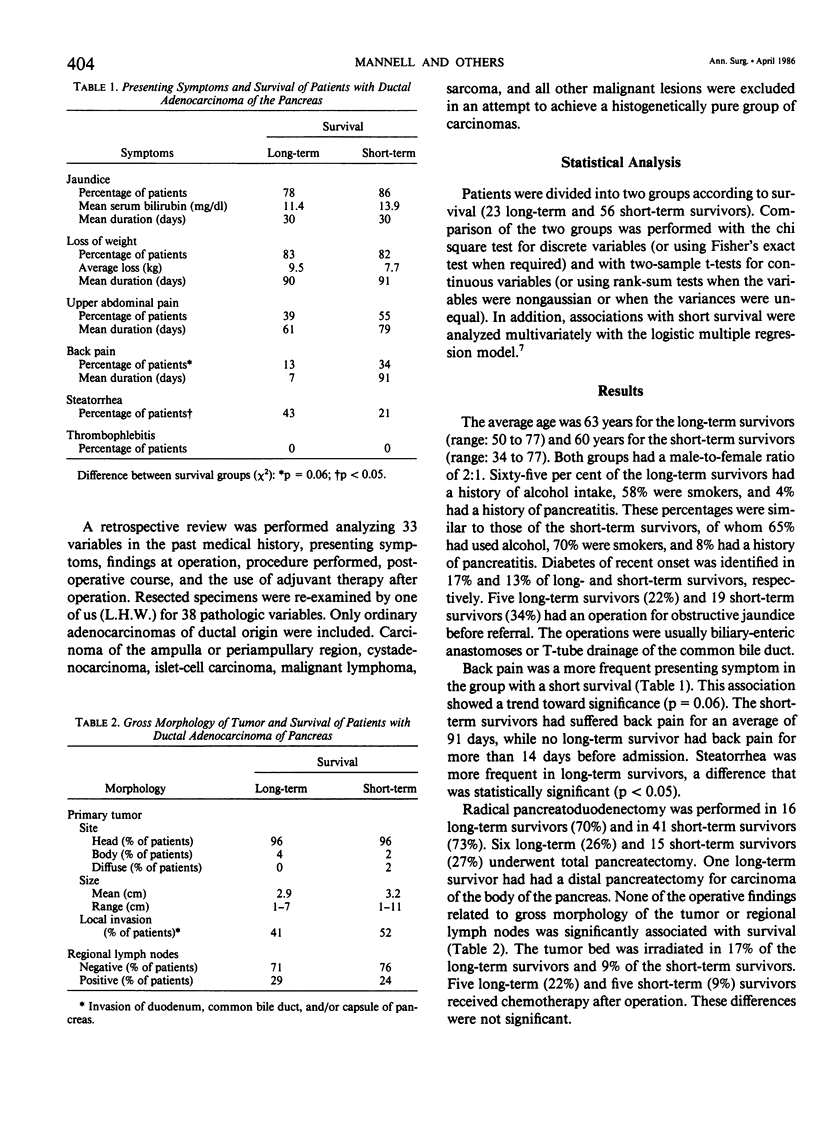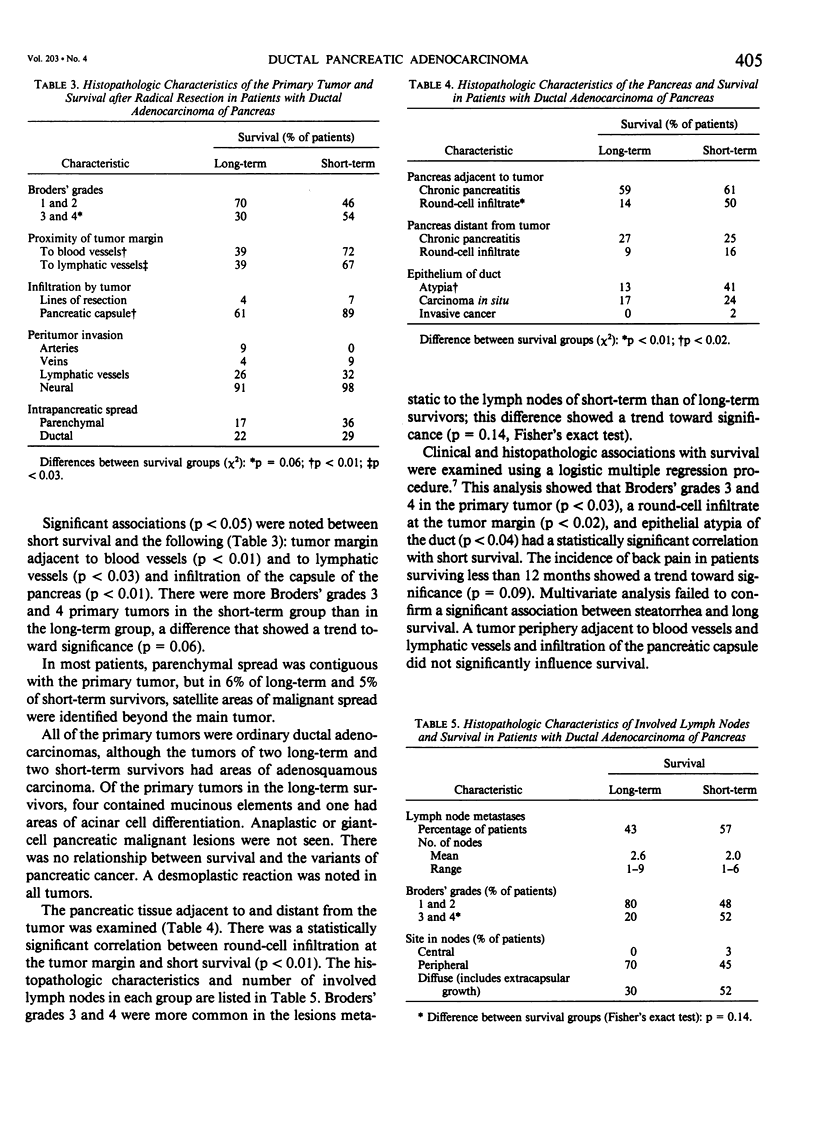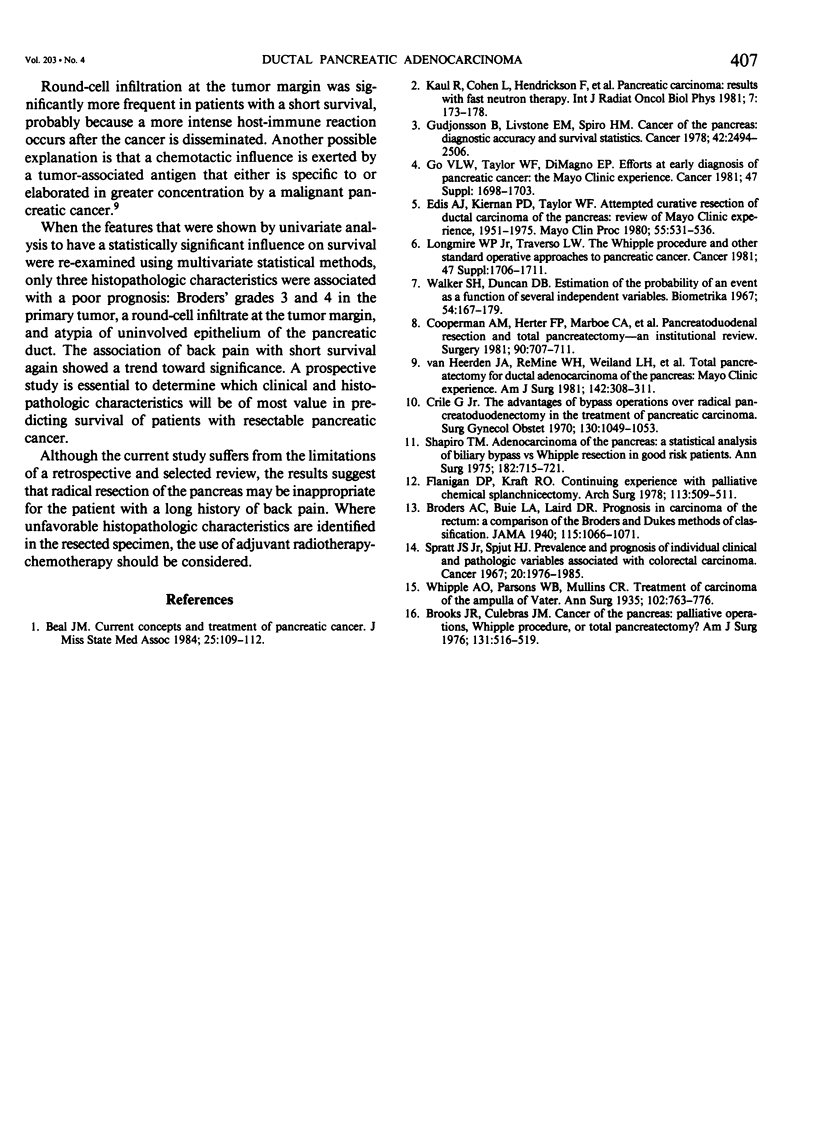Abstract
Twenty-three patients with pancreatic cancer who survived greater than or equal to 3 years after surgical treatment and 56 who survived less than 12 months were studied. The association of steatorrhea with long survival was significant (p less than 0.05), and the association of back pain with short survival showed a trend toward significance (p = 0.06). Other presenting symptoms, as well as the age, sex, or past medical history of the patients; the gross morphology of the tumor and regional lymph nodes; the operations performed; and the use of postoperative adjuvant therapy had no significant influence on survival. Certain histopathologic characteristics of the resected specimens were significantly associated (p less than 0.05) with a poor prognosis: malignant infiltration of the pancreatic capsule, proximity of the tumor to lymphatic and blood vessels, a round-cell infiltrate at the tumor margin, and epithelial atypia in the uninvolved pancreatic ducts. The association of Broders' grades 3 and 4 in the primary tumor and metastases to lymph nodes showed a trend toward significance with short survival. Multivariate analysis confirmed that the associations of Broders' grades 3 and 4 in the primary tumor, a round-cell infiltrate at the tumor margin, and atypia of the pancreatic ductal epithelium with short survival were statistically significant.
Full text
PDF




Selected References
These references are in PubMed. This may not be the complete list of references from this article.
- Beal J. M. James Grant Thompson Memorial Lecture. Current concepts and treatment of pancreatic cancer. J Miss State Med Assoc. 1984 May;25(5):109–112. [PubMed] [Google Scholar]
- Brooks J. R., Culebras J. M. Cancer of the pancreas. Palliative operation, Whipple procedure, or total pancreatectomy? Am J Surg. 1976 Apr;131(4):516–520. doi: 10.1016/0002-9610(76)90167-7. [DOI] [PubMed] [Google Scholar]
- Cooperman A. M., Herter F. P., Marboe C. A., Helmreich Z. V., Perzin K. H. Pancreatoduodenal resection and total pnacreatectomy--an institutional review. Surgery. 1981 Oct;90(4):707–712. [PubMed] [Google Scholar]
- Crile G., Jr The advantages of bypass operations over radical pancreatoduodenectomy in the treatment of pancreatic carcinoma. Surg Gynecol Obstet. 1970 Jun;130(6):1049–1053. [PubMed] [Google Scholar]
- Edis A. J., Kiernan P. D., Taylor W. F. Attempted curative resection of ductal carcinoma of the pancreas: review of Mayo Clinic experience, 1951-1975. Mayo Clin Proc. 1980 Sep;55(9):531–536. [PubMed] [Google Scholar]
- Flanigan D. P., Kraft R. O. Continuing experience with palliative chemical splanchnicectomy. Arch Surg. 1978 Apr;113(4):509–511. doi: 10.1001/archsurg.1978.01370160167029. [DOI] [PubMed] [Google Scholar]
- Go V. L., Taylor W. F., DiMagno E. P. Efforts at early diagnosis of pancreatic cancer: the Mayo Clinic Experience. Cancer. 1981 Mar 15;47(6 Suppl):1698–1705. doi: 10.1002/1097-0142(19810315)47:6+<1698::aid-cncr2820471439>3.0.co;2-9. [DOI] [PubMed] [Google Scholar]
- Gudjonsson B., Livstone E. M., Spiro H. M. Cancer of the pancreas: diagnostic accuracy and survival statistics. Cancer. 1978 Nov;42(5):2494–2506. doi: 10.1002/1097-0142(197811)42:5<2494::aid-cncr2820420554>3.0.co;2-r. [DOI] [PubMed] [Google Scholar]
- Kaul R., Cohen L., Hendrickson F., Awschalom M., Hrejsa A. F., Rosenberg I. Pancreatic carcinoma: results with fast neutron therapy. Int J Radiat Oncol Biol Phys. 1981 Feb;7(2):173–178. doi: 10.1016/0360-3016(81)90433-8. [DOI] [PubMed] [Google Scholar]
- Longmire W. P., Jr, Traverso L. W. The Whipple procedure and other standard operative approaches to pancreatic cancer. Cancer. 1981 Mar 15;47(6 Suppl):1706–1711. doi: 10.1002/1097-0142(19810315)47:6+<1706::aid-cncr2820471441>3.0.co;2-7. [DOI] [PubMed] [Google Scholar]
- Shapiro T. M. Adenocarcinoma of the pancreas: a statistical analysis of biliary bypass vs Whipple resection in good risk patients. Ann Surg. 1975 Dec;182(6):715–721. doi: 10.1097/00000658-197512000-00010. [DOI] [PMC free article] [PubMed] [Google Scholar]
- Spratt J. S., Jr, Spjut H. J. Prevalence and prognosis of individual clinical and pathologic variables associated with colorectal carcinoma. Cancer. 1967 Nov;20(11):1976–1985. doi: 10.1002/1097-0142(196711)20:11<1976::aid-cncr2820201125>3.0.co;2-m. [DOI] [PubMed] [Google Scholar]
- Walker S. H., Duncan D. B. Estimation of the probability of an event as a function of several independent variables. Biometrika. 1967 Jun;54(1):167–179. [PubMed] [Google Scholar]
- Whipple A. O., Parsons W. B., Mullins C. R. TREATMENT OF CARCINOMA OF THE AMPULLA OF VATER. Ann Surg. 1935 Oct;102(4):763–779. doi: 10.1097/00000658-193510000-00023. [DOI] [PMC free article] [PubMed] [Google Scholar]
- van Heerden J. A., ReMine W. H., Weiland L. H., McIlrath D. C., Ilstrup D. M. Total pancreatectomy for ductal adenocarcinoma of the pancreas. Mayo Clinic experience. Am J Surg. 1981 Sep;142(3):308–311. doi: 10.1016/0002-9610(81)90336-6. [DOI] [PubMed] [Google Scholar]


